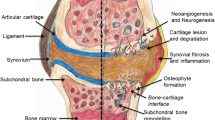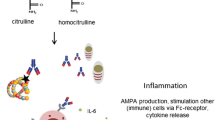Abstract
Angiogenesis is an important component of the development of chronic inflammatory diseases such as rheumatoid arthritis. It is known that clinically used anti-rheumatic drugs exert, in part, effects on the angiogenic response. Little work, however, has investigated the potential of experimental angiostatic therapies in chronic inflammatory disease models. The effect of one such angiostatic treatment, cortisone combined with heparin, was tested in anin vivo model of granuloma-mediated cartilage degradation. Angiostatic treatment significantly retarded the growth of granulomatous tissue, mononuclear cell influx into the granuloma, and the degradation of juxtaposed cartilage. This correlated with a decrease in the vascularity of the granulomatous tissue. Modulation of this component of pathogenesis of “angiogenesis-dependent disease” may be useful as a new therapeutic approach.
Similar content being viewed by others
References
H. G. Fassbender and A. Simmling-Annefield,The potential aggressiveness of synovial tissue in rheumatoid arthritis. J. Pathol.139, 399–406 (1983).
J. Folkman,How is blood vessel growth regulated in normal and neoplastic tissue? G. H. A. Clowes Memorial Award Lecture. Cancer Res.46, 467–473 (1986).
P. R. Colville-Nash and D. L. Scott,Angiogenesis and rheumatoid arthritis: Pathogenic and therapeutic implications. Ann. Rheum. Dis.51 (7), 919–925 (1992).
M. Takigawa, Y. Nishida, F. Suzuki, J. Kishi, K. Yamashita and T. Hayakawa,Induction of angiogenesis in chick yolksac membrane by polyamines and its inhibition by tissue inhibitors of metalloproteinases (TIMP and TIMP-2). Biochem. Biophys. Res. Commun.171, 1264–1271 (1990).
D. Ingber, T. Fujita, S. Kishimoto, K. Sudo, T. Kanamaru, H. Brem and J. Folkman,Synthetic analogues of fumagillin that inhibit angiogenesis and suppress tumour growth. Nature348, 555–557 (1990).
R. Crum, S. Szabo and J. Folkman,A new class of steroids inhibits angiogenesis in the presence of heparin or a heparin fragment. Science230, 1375–1378 (1985).
J. Folkman, R. Langer, R. J. Linhardt, C. Haudenschild and S. Taylor,Angiogenesis inhibition and tumour regression caused by heparin or a heparin fragment in the presence of cortisone. Science221, 719–725 (1983).
D. J. Peacock, M. L. Banquerigo and E. Brahn,Angiogenesis inhibition suppresses collagen arthritis. InProceedings of the 55th Annual Meeting of the American College of Rheumatology. Arth. Rheum,34 (9), Suppl, Abstract 74, S45, (1991).
F. B. De Brito, A. R. Moore, M. J. G. Holmes and D. A. Willoughby,Cartilage damage by a granulomatous reaction in a murine species. Br. J. Exp. Path.68, 675–686 (1987).
F. B. De Brito, M. J. G. Holmes, S. L. Carney and D. A. Willoughby,Drug effects on a novel model of connective tissue breakdown. Agents and Actions21, 287–289 (1987).
K. M. K. Bottomley, R. J. Griffiths, T. J. Rising and A. Steward,A modified rat air pouch model for evaluating the effects of compounds on granuloma-induced cartilage degradation. Br. J. Pharmacol.93, 627–635 (1988).
J. F. Woessner,The determination of hydroxyproline in tissue and protein samples containing small proportions of imino acids, Arch. Biochem. Biophys.93, 440–447 (1961).
P. J. Bailey, A. Sturm and B. Lopez-Ramos,A biochemical study of the cotton pellet granuloma in the rat: Effects of dexamethasone and indomethacin. Biochem. Pharmacol.31, 1213–1218 (1982).
J. W. Woollen, R. Heyworth and P. G. Walker,Studies on glucosaminidase. Biochem. J.78, 111–116 (1961).
M. Kimura, K. Amemiya, T. Yamada and J. Suzuki,Quantitative method for measuring adjuvant-induced granuloma angiogenesis in insulin treated diabetic mice. J. Pharmacobio. Dyn.9, 442–446 (1986).
A. R. Moore, T. H. P. Hanahoe, F. M. Desa, D. W. Howat, C. L. Chander and D. A. Willoughby,A procedure for assaying the component parts of rat femoral head cartilage and it's application to an in vivo model of cartilage breakdown. Int. J. Immunopathol. Pharmacol.1, 5–10 (1988).
R. W. Farndale, C. A. Sayer and A. J. Barrett,A direct spectrophotometric microassay for sulfated glycosaminoglycans in cartilage culture. Connect. Tissue Res.9, 247–251 (1982).
F. P. Altman,Quantitative dehydrogenase histochemistry with special reference to the pentose shunt dehydrogenases. Prog. Histochem. Cytochem.4, 225 (1972).
B. Henderson,Quantitative cytochemical measurement of glyceraldehyde-3-phosphate dehydrogenase activity. Histochemistry48, 191–204 (1976).
J. Chayen, L. Bitensky and R. G. Butcher,Lactate Dehydrogenase. InPractical Histochemistry, pp. 197–199. Wiley, London, 1973.
T. A. Springer,Adhesion receptors of the immune system. Nature346, 425–431 (1990).
M. R. Windt and L. J. Rosenwasser,Human vascular endothelial cells produce interleukin-1. Lymphokine Res.3, 281a (1984).
F. R. Jirik, T. J. Podor, T. Hirano, T. Kishimoto, D. J. Loskutoff, D. A. Carson and M. Lotz,Bacterial lipopolysaccharide and inflammatory mediators augment IL-6 secretion by human endothelial cells. J. Immunol.1, 144–147 (1989).
A. Mantovani and E. Dejana,Cytokines as communication signals between leukocytes and endothelial cells. Immunol. Today10, 370–375 (1989).
J. S. Pober and M. Gimbrone,Expression of Ia-like antigens by human vascular endothelial cells is inducible in vitro: Demonstration by monoclonal antibody binding and immunoprecipitation. Proc. Nat. Acad. Sci.79, 6641–6645 (1982).
P. E. Dicorleto and D. F. Bowen-Pope,Cultured endothelial cells produce a platelet-derived growth factor-like protein. Proc. Natl. Acad. Sci.80, 1919–1923 (1983).
R. G. Gryglewski, R. M. Botting and J. R. Vane,Mediators produced by the endothelial cell. Hypertension12, 530–548 (1988).
E. A. Jaffe,Endothelial cells. InInflammation: Basic Principles and Clinical Correlates. (Eds. J. I. Gallin, I. M. Goldstein and R. Snyderman) pp. 559–576, Raven Press, New York 1988.
E-D. Jarasch, G. Bruder and H. W. Heid,Significance of xanthine oxidase in capillary endothelial cells. Acta Scand. Physiol.548 (suppl), 39–46 (1986).
D. A. Willoughby, M. P. S. Seed, A. R. Moore, P. R. Colville-Nash and C. L. Chander,New areas for therapeutic intervention in the treatment of rheumatic disease. Therapie46, 461–467 (1991).
C. R. Stevens, D. R. Blake, P. Merry, P. A. Revell and J. R. Levick,A comparative study by morphometry of the microvasculature in normal and rheumatoid synovium. Arth. Rheum.34, 1508–1513 (1991).
M. Rooney, D. Condell, W. Quinlan, L. Daly, A. Whelan, C. Feighery and B. Bresnihan,Analysis of the histologic variation in rheumatoid arthritis. Arth. Rheum.31, 956–963 (1988).
J. Folkman and D. E. Ingber,Angiostatic steroids. Method of discovery and mechanism of action. Ann. Surg.206, 374–383 (1987).
D. E. Ingber, J. A. Madri and J. Folkman,A possible mechanism for inhibition of angiogenesis by angiostatic steroids: Induction of capillary basement membrane dissolution. Endocrinology119(4), 1768–1775 (1986).
N. G. Tanaka, N. Sakamoto, A. Tohgo, Y. Nishiyama and H. Ogawa,Inhibitory effects of anti-angiogenic agents on neovascularization and growth of the chorioallantoic membrane (CAM). The possibility of a new CAM assay for angiogenesis inhibition. Exp. Pathol.30, 143–150 (1986).
D. W. Beck, J. J. Olson and R. J. Linhardt,Effect of heparin, heparin fragments, and corticosteroids on cerebral endothelial cell growth in vitro and in vivo. J. Neuropathol. Exp. Neurol.45, 503–512 (1986).
R. Cariou, J. L. Harousseau and G. Tobelem,Inhibition of human endothelial cell proliferation by heparin and steroids. Cell. Biol. Int. Rep.12, 1037–1047 (1988).
C. L. Stokes, P. B. Weisz, S. K. Williams and D. A. Lauffenburger,Inhibition of microvascular endothelial cell migration by beta-cyclodextrin tetradecasulfate and hydrocortisone. Microvasc. Res.40, 279–284 (1990).
I. Harada, T. Kikuchi, Y. Shimomura, M. Yamamoto, H. Ohno and N. Sato,The mode of action of anti-angiogenic steroid and heparin. InAngiogenesis. (Eds. R. Steiner, P. B. Weisz and R. Langer), pp. 445–448, Birkhauser, Basel 1992.
C. L. Chander, P. R. Colville-nash, A. R. Moore, D. W. Howat, F. M. Desa and D. A. Wiloughby,The effects of heparin and cortisone on an experimental model of pannus. Int. J. Tissue React.11, 113–116 (1989).
N. E. Robertson, C. M. Discafani, E. C. Downs, J. A. Hailey, O. Sarre, R. L. J. Runkle, T. L. Popper and M. L. Plunkett,A quantitative in vivo mouse model used to assay inhibitors of tumor-induced angiogenesis. Cancer Res.51, 1339–1344 (1991).
Author information
Authors and Affiliations
Rights and permissions
About this article
Cite this article
Colville-Nash, P.R., El-Ghazaly, M. & Willoughby, D.A. The use of angiostatic steroids to inhibit cartilage destruction in anin vivo model of granuloma-mediated cartilage degradation. Agents and Actions 38 (Suppl 1), 126–134 (1993). https://doi.org/10.1007/BF02027224
Received:
Accepted:
Issue Date:
DOI: https://doi.org/10.1007/BF02027224




